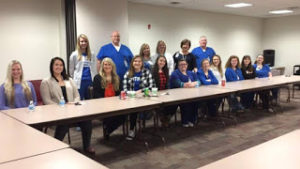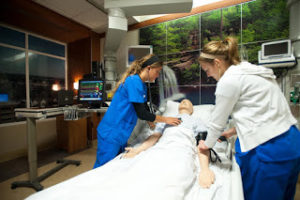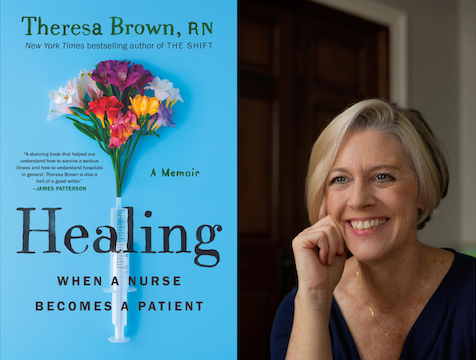This article was originally published by Kentucky Health News. Reprinted with permission as part of the CHMP Nursing and Healthcare Workforce Media Fellowship.
Some hospitals in Kentucky can’t find enough nurses; they and nursing colleges work toward short-term and long-term solutions.
While studies show Kentucky will have a surplus of registered nurses in the next decade, right now many of the state’s hospitals are struggling to hire enough nurses to care for patients.
“I am hoping this is cyclical,”Susan Ellis, the vice president of Patient Care Services at Highlands Regional Medical Center in Prestonsburg, Kentucky, said. “But my fear is that this one is much deeper than any of the past nursing shortages that I have seen, and by deeper I mean it is spread much wider.”
Most of the state’s critical-access hospitals, which usually have fewer than 20 patients at a time, haven’t been hit by the shortage. But at any given time larger Kentucky hospitals may have between a 10 percent and 40 percent vacancy rate, Ellis said.
Highlands is a 184-bed facility that needs about 120 registered nurses in its clinical area and is about 24 short, or 20 percent.
“We are feeling it in our facilities,” Ellis said. “And surrounding facilities that I have spoken to, some of their chief nursing officers, they are feeling it too. . . . You really can’t run your facility without your registered nurses; they are at the patient’s bedsides.”
The University of Kentucky, which operates a 569-bed hospital that largely serves Central and Eastern Kentucky, has also struggled with the shortage of nurses.
“I think most of the folks in Lexington who are trying to hire registered nurses would share a similar perspective,” Colleen Swartz, the chief nurse executive at UK HealthCare said. “For example, as recently as three years ago, which would put us in that 2013-14 time-frame, we would post a registered nurse position and get 20 applications for it, but right now we have positions that we have posted and re-posted and had no applicants.”
Kentucky has about 45,500 full-time employed RNs, whose average annual salary is about $60,000, according to the federal Bureau of Labor Statistics. The Kentucky Board of Nursing website reports 69,337 active RN licenses in the state.
The latest Kentucky Occupational Outlook to 2024 report said the state would need an additional 16,047 full-time registered nurses between 2014 and 2024, or a 36 percent increase from the estimated 45,086 in the 2014 workforce to the projected need of 61,133. “Health-care-related occupations are expected to grow at such a high rate primarily because of Kentucky’s aging population,” the report said.
By 2030, one in five Americans will be 65 or older, the U.S. Census Bureau predicts. The National Council on Aging says 80 percent of older adults have at least one chronic health condition, and 68 percent have at least two.
Peter Buerhaus, a health-care workforce expert at Montana State University, agreed that the aging population will increase the need for new nurses, but added that states should also pay attention to their retiring RN workforce because more than one-third of RNs are likely to retire over the next 10 years.
“One million nurses who are over the age of 50 are going to be retiring, and with that retirement goes an awful lot of knowledge and skill and experience,” Buerhaus said. “It is a major, major quantitative and qualitative change in nursing.” He added that health reform and the primary-care provider shortage, which is expected to worsen over the next 10 years, will also drive the need for more nurses.
Retirement does not appear to be as big a problem in Kentucky as in most states. The average age of a Kentucky nurse is 40; the national average is 50.
Swartz said UK HealthCare didn’t have any immediate concerns about losing nurses to retirement, but said the hospital has worked with its older nurses to figure out how to best manage the large geographic footprint of the facility as it has grown.
“There are nurses who have been here, say 20 years,” Swartz said. “You just can’t replace the judgment and the knowledge and the critical thinking that they have through those years of experience. It’s priceless to us.”
Buerhaus said there isn’t a nursing shortage from “a big macro national perspective,” but that some areas of the country, especially rural areas, are experiencing a shortage. “It is an uneven picture across the country.”
Buerhaus noted that his research, published in the journal Nursing Outlook, forecast that Kentucky, as part of the East South Central region of the U.S., is expected to have “substantial growth” in its number of full-time registered nurses between 2015 to 2030.
“What this suggest to me is that in the East South Central part of this country we are going to have fewer older nurses who are going to retire and a stronger growth of young people coming in,” he said about his research findings.
A 2014 U.S. Department of Health and Human Services report says that nationwide there will be a surplus of 340,000 full-time equivalent registered nurses in 2025, and a surplus of 16,500 in Kentucky.
However, another report by Georgetown University, which it says uses a study methodology based on nursing demand and “active supply,” says that by 2020, the nation will have a shortage of about 193,000 nursing professionals by 2020.
Whatever forecast is correct, that doesn’t affect today’s shortage of nurses in Kentucky, which is forcing hospitals and nursing schools to find creative ways to fill those vacancies.
In Part II: innovative approaches help Kentucky hospitals meet their nurse staffing challenges.
This article was produced as part of the Health Care Workforce Media Fellowship, run by the Center for Health, Media & Policy, New York, N.Y. The fellowship is supported by a grant from the Johnson & Johnson Foundation. Kentucky Health News is an independent news service of the Institute for Rural Journalism and Community Issues, based in the School of Journalism and Media at the University of Kentucky, with support from the Foundation for a Healthy Kentucky.











